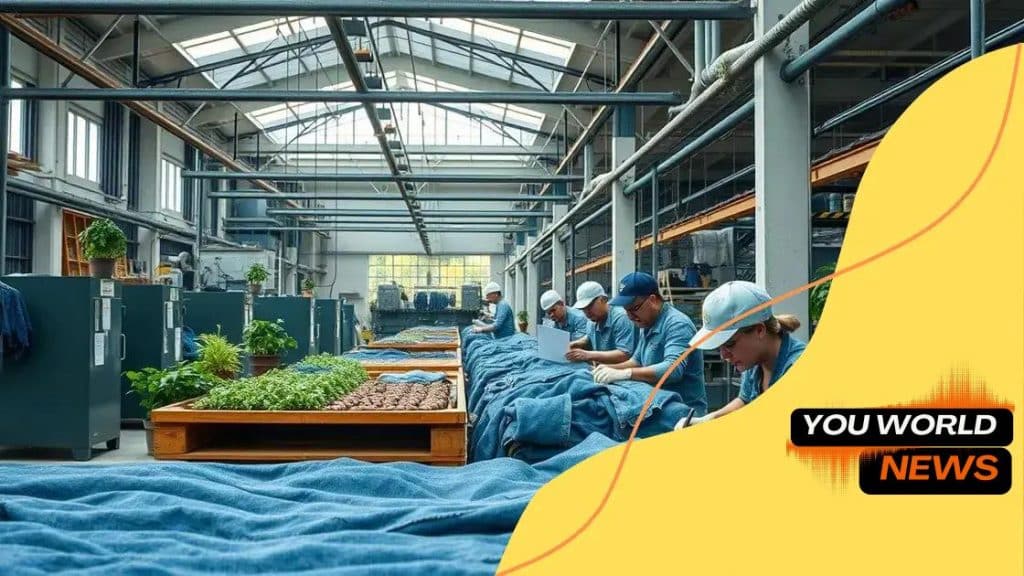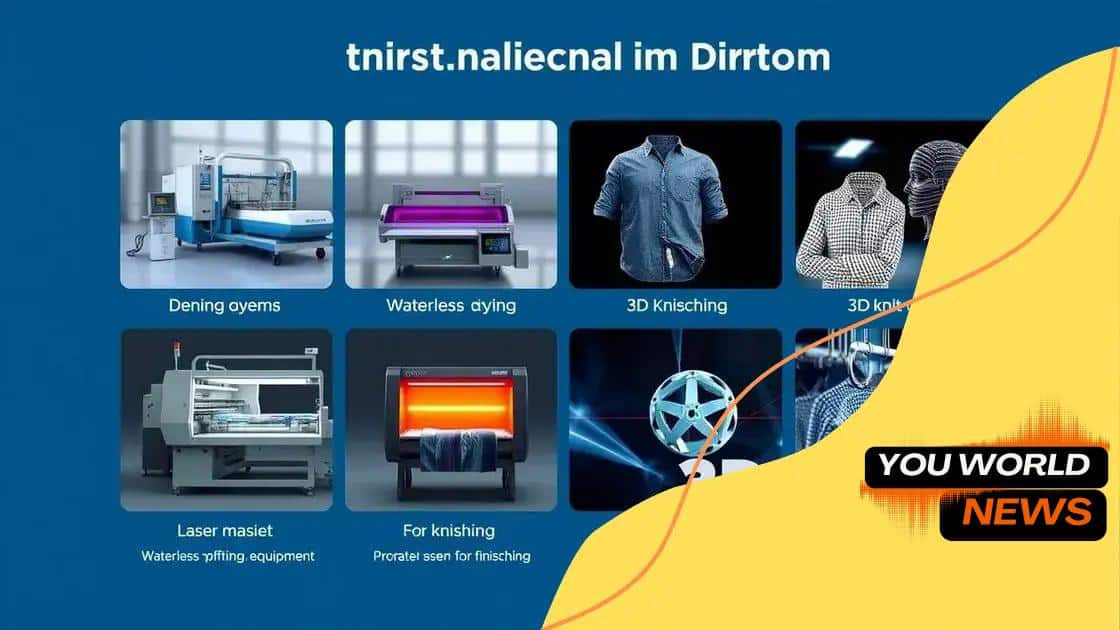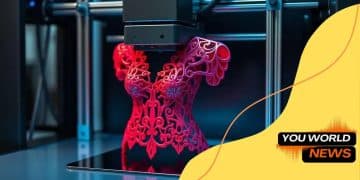The evolution of sustainable denim production

The evolution of sustainable denim production involves using eco-friendly practices, reducing water consumption, and minimizing chemical usage, all aiming to lower environmental impact while meeting consumer demand for ethical fashion.
The evolution of sustainable denim production is shaking up an industry known for its environmental challenges. By exploring innovative practices and technologies, we can uncover how denim manufacturing can become more eco-friendly. What changes have occurred, and how do they affect both the planet and consumers?
Understanding sustainable denim practices
Understanding sustainable denim practices is essential as the demand for eco-friendly fashion grows. The shift towards more responsible production methods shows how the industry adapts to protect our planet.
Sustainable denim practices focus on reducing the environmental impact of production. This includes methods such as using organic cotton, reducing water consumption, and utilizing eco-friendly dyes. By implementing these practices, brands can contribute to a healthier environment.
Why Choose Sustainable Denim?
Choosing sustainable denim not only benefits the environment but also supports ethical labor practices. Many consumers are now looking for brands that prioritize sustainable production. This shift encourages companies to be more responsible in their choices.
Key Practices in Sustainable Denim Production
- Using organic or recycled materials
- Implementing water-saving techniques
- Utilizing less harmful dyes and chemicals
- Ensuring fair labor practices for workers
As we explore these approaches, it becomes clear that each step taken towards sustainability matters. Brands are developing innovative ways to make denim more eco-friendly. This includes recycling old denim to create new fabric and using sustainable manufacturing technologies. By enhancing these practices, the impact of traditional denim production can be significantly reduced.
Moreover, the rise of sustainable denim practices is encouraging discussions around circular fashion. This concept promotes reusing and recycling clothing, helping to minimize waste. Understanding these practices allows consumers to make informed choices, fostering a movement towards a more sustainable fashion industry.
Key players in the sustainable denim evolution
Key players in the sustainable denim evolution are shaping the future of fashion. These brands and organizations are leading the way with innovative practices and a commitment to eco-friendly products.
Many well-known brands are making strides towards sustainability. Companies like Levi’s, Patagonia, and H&M have initiated programs focused on sustainable production. Their efforts include using organic materials and improving labor practices.
Innovative Startups
In addition to established brands, numerous startups are innovating how denim is produced. Companies like Reformation and Nudie Jeans focus on transparency in sourcing and production. They ensure that their jeans not only look good but are also made ethically.
Non-Profit Organizations
Non-profit organizations also play a crucial role. Initiatives such as Fashion Revolution and Environmental Defense Fund advocate for sustainable practices in the industry. They raise awareness and empower consumers to make better choices.
- Promoting circular fashion
- Encouraging sustainable materials
- Offering educational resources
- Collaborating with brands for change
These players are not only leading by example, but they are also paving the way for future developments in sustainable denim. By joining forces, they are creating a movement that inspires others in the fashion industry to follow suit. The evolution is not just about clothing; it’s about a new mindset that values the planet.
Innovative technologies in denim production

Innovative technologies in denim production are transforming the way jeans are made. These advancements help brands reduce their environmental impact while maintaining high-quality products. From digital printing to laser treatments, the options are expanding.
One of the most exciting technologies is waterless dyeing. This technique drastically cuts down water usage in the dyeing process. Brands that adopt this technology not only save resources but also lower pollution. Another significant innovation is the use of recycled materials. By incorporating recycled denim and other fabrics, companies reduce waste and conserve resources, making the denim cycle more sustainable.
Laser Technology in Denim
Lasers have revolutionized the finishing process in denim production. With laser technology, brands can create distressed finishes without excessive water or harmful chemicals. This method is efficient and allows for precise designs, making it possible to produce unique looks.
3D Knitting and Printing
3D knitting and printing are also gaining traction in the industry. These methods allow for more personalized designs, reducing overproduction. By creating garments on demand, brands minimize waste and give consumers more control over their style.
- Improved energy efficiency
- Reduced chemical use
- Enhanced design possibilities
- Shorter production cycles
As sustainable practices become necessary, these innovative technologies will play a critical role in shaping the future of denim production. By embracing these advancements, the industry can move towards a more sustainable and responsible model, benefitting both consumers and the environment.
Environmental impact of traditional vs sustainable denim
The environmental impact of traditional versus sustainable denim is a critical topic in the fashion industry. Understanding these differences helps consumers make informed choices. Traditional denim production is often water-intensive and involves harmful chemicals. This production method not only wastes millions of gallons of water but also pollutes rivers and soils.
Sustainable denim, on the other hand, strives to minimize this impact. Brands adopting sustainable practices focus on using organic cotton, which requires less water and avoids toxic pesticides. These eco-friendly approaches can lead to a cleaner environment by reducing pollution and conserving resources.
Water Usage Comparison
Water usage is a significant concern in denim production. Traditional methods can consume up to 7,000 liters of water to make just one pair of jeans. In contrast, sustainable methods, such as using waterless dyeing technology, reduce this number dramatically. Some brands claim to use less than 100 liters per pair.
Chemical Use in Production
The chemicals used in traditional denim processes contribute to environmental destruction. Conventional dyeing methods often involve toxic substances that can leach into nearby water sources. Sustainable practices aim to eliminate these harmful chemicals. Brands are increasingly using natural dyes and safer alternatives that do not harm the environment.
- Reduction of water pollution
- Decreased carbon emissions from production
- Less plastic waste from synthetic fibers
- Conservation of biodiversity through responsible sourcing
By highlighting these differences, it’s clear that sustainable denim has a much lower environmental impact than its traditional counterpart. As awareness grows, more consumers are opting for brands that prioritize eco-friendly practices, pushing the industry towards a greener future.
Future trends in sustainable denim
Future trends in sustainable denim show promising developments that aim to further reduce environmental impact. Innovations are emerging as designers and brands realize the need for eco-friendly solutions in an ever-changing fashion landscape.
One significant trend is the rise of circular fashion. This concept encourages recycling and upcycling old denim into new products. Instead of discarding jeans, consumers can send them back to brands for reuse. This reduces waste and promotes a sustainable lifecycle.
Biomechanics and Smart Fabrics
Another exciting area is the integration of biomechanics and smart fabrics into denim. These textiles can adapt to different body types and movements, providing comfort and practical benefits. Additionally, smart fabrics may incorporate features like moisture-wicking and temperature regulation, making denim more versatile and functional.
Enhanced Focus on Transparency
As consumers become more aware, there is an increasing demand for transparency in production practices. Brands are expected to disclose their supply chain information, including where materials come from and how workers are treated. This transparency helps consumers make informed choices about their purchases.
- Increased use of recycled materials
- Development of eco-friendly dyes and finishes
- Collaboration between brands and environmental organizations
- Focus on empowering local artisans and fair labor practices
Technologies like blockchain are also making their way into the fashion industry to verify claims of sustainability. This ensures that brands uphold their promises to protect the environment and treat their workers fairly. As these trends evolve, sustainable denim will become more accessible, fostering a broader movement towards eco-conscious fashion.
FAQ – Frequently Asked Questions about Sustainable Denim
What makes denim sustainable?
Sustainable denim is made using eco-friendly practices, such as organic cotton, waterless dyeing, and reduced chemical use.
How does traditional denim production impact the environment?
Traditional denim production typically uses excessive water and harmful chemicals, leading to pollution and resource depletion.
What are the benefits of circular fashion in denim?
Circular fashion promotes recycling, reducing waste by turning old denim into new products instead of discarding it.
Why is transparency important in denim production?
Transparency allows consumers to understand where their products come from and ensures ethical practices in the supply chain.





